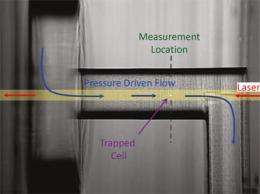Scientists demonstrate the power of optical forces in blood cell identification

(PhysOrg.com) -- U.S. Naval Research Laboratory researchers Dr. Sean J. Hart, Dr. Colin G. Hebert and Mr. Alex Terray have developed a laser-based analysis method that can detect optical pressure differences between populations or classes of blood cells that does not rely on prior knowledge, antibodies, or fluorescent labels for discrimination.
"Biological analysis systems that rely on labels can be costly, labor intensive and depend upon prior knowledge of the target in question," says Dr. Hart, NRL Chemistry Division. "Using whole blood, which is composed of a variety of cell types, we have demonstrated the power of optical forces to separate different blood components."
When a laser beam impinges on a biological particle, a force is generated due to the scattering and refraction of photons. The resulting force is called optical pressure and can be used to physically move a biological cell, suspended in water, several millimeters.
Using this laser technique, scientists are able to exploit the inherent differences in optical pressure, which arise from variations in particle size, shape, refractive index, or morphology, as a means of separating and characterizing particles.
As an initial step toward developing a system for label-free sorting and characterization of blood components, the optical pressures of purified human blood components, including lymphocytes, monocytes, granulocytes, and erythrocytes, have been determined. Significant differences exist between the cell types, indicating the potential for separations based on these 'optical pressures.'
"While additional research is required, this is an important step toward the development of a system for the label-free optical fractionation of blood cells and components based on intrinsic characteristics," adds Dr. Hart.
In general, the throughput for optical-based sorting has been relatively low, on the order of tens of cells per second. However, with an increase in both fluid flow and laser power, the throughput could be increased significantly, exceeding 100 particles per second in some favorable cases.
Such a system could be used in the future for antibody-free detection of blood-borne pathogens for the prevention of sepsis and other diseases as well as the detection of biological threat agents.
Provided by Naval Research Laboratory
















